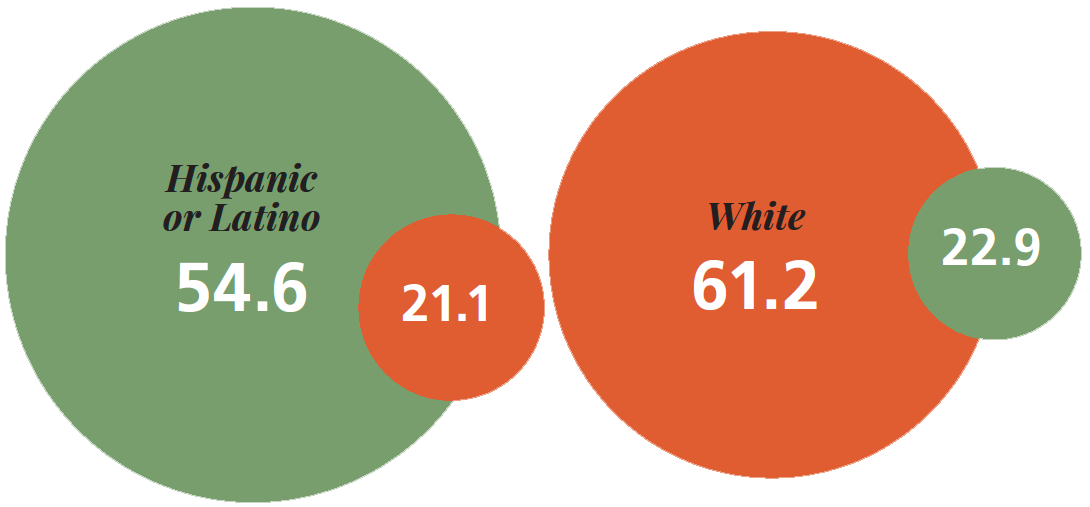






 hese gaps persist despite research highlighting the benefits of having a diverse teaching force educating a diverse student body,” reads the California Commission on Teacher Credentialing’s 2017–18 annual report to the Legislature. A who’s who of state educational agencies, associations and advocacy groups, including CSBA, have echoed the CTC’s findings over the last several years. “Despite a growing body of evidence that demonstrates how a diverse faculty can accelerate achievement, California’s teacher workforce fails to reflect the diversity of its student body,” said CSBA President Xilonin Cruz-Gonzalez.
hese gaps persist despite research highlighting the benefits of having a diverse teaching force educating a diverse student body,” reads the California Commission on Teacher Credentialing’s 2017–18 annual report to the Legislature. A who’s who of state educational agencies, associations and advocacy groups, including CSBA, have echoed the CTC’s findings over the last several years. “Despite a growing body of evidence that demonstrates how a diverse faculty can accelerate achievement, California’s teacher workforce fails to reflect the diversity of its student body,” said CSBA President Xilonin Cruz-Gonzalez.
The public is also showing they understand the significance of the issue, as illustrated in the 2020 Policy Analysis for California Education/USC Rossier poll of California voters. Seventy percent of registered voters rated the issue of increasing diversity in the teacher workforce as at least a 6 on a 1-10 importance scale; 24 percent said the issue is a top priority.
With the statistical chasm — coupled with persistent achievement gaps for many of the student groups whose race is underrepresented among teachers — serving as a backdrop, the goal of diversifying the teacher workforce has taken on newfound energy in California. From the halls of the Capitol to the halls of schools, educational leaders are looking to not only attract and hire teachers of color but, just as importantly, retain them.
Gov. Newsom’s focus on the issue mirrors one of the top priorities for State Superintendent of Public Instruction Tony Thurmond and the California Department of Education. Since his election in fall 2018, Thurmond has convened a work group of experts and hosted several panel events focused on attracting and retaining teachers of color. At an April 2019 event, Thurmond acknowledged the state’s shortcomings and said the CDE is working to expand programs for teachers of color, particularly by building a pipeline for men.
 % of student population
% of student population % of teachers
% of teachers




* Note: 4.6 percent of teachers did not report their race or ethnicity
The Governor and state superintendent’s high-profile acknowledgement of the matter have struck a chord with Travis J. Bristol, an assistant professor in the University of California, Berkeley Graduate School of Education who focuses on practices and policies that support teachers of color. Beyond his research, Bristol is also involved in a three-year pilot program in the Compton Unified School District to improve the retention rates of male teachers of color. He previously taught English in the New York City public school system.
“I think there are several key conditions that I feel extremely confident that California is going to really act on teacher diversity,” Bristol said in reflecting on the leadership of not only Gov. Newsom and Thurmond but State Board of Education President Linda Darling-Hammond, a mentor and former professor of Bristol’s at Stanford University. “And I think that there’s political will in Sacramento by the Governor, given the recent budget, to greatly put the muscle behind this effort.”
Joining Bristol as a panelist at the CDE event in April 2019 was Daryl Camp, now superintendent of the Bay Area’s San Lorenzo Unified School District and a governance services consultant for CSBA. At the time, Camp was superintendent of Riverbank USD, southeast of Stockton.
In speaking about the power of representation in schools, Camp thought back to an exercise in Riverbank USD when he asked a group of third-graders which gender and race came to mind when he listed off several professions. While not related to race, Camp said he was heartbroken when a girl responded that “man” came to mind when he asked about the profession of lawyer because “girls aren’t smart enough.” “I think it’s important for students to see educators that look like them, because they’re making life and career decisions right in front of them,” Camp said.


A number of districts, often partnering with institutions of higher education, are following through on that charge.
Though the district is still wrestling with common teacher shortages in special education, math and science, the teacher pipeline statistics are points of pride for Teresa Morales-Young, administrator of the district’s Teacher Development Department. She oversees 15 programs, ranging from a teacher academy for current students to residency options to teacher leadership opportunities; six of the programs involve partnerships with area colleges and universities.
But the pipeline program’s success didn’t appear overnight, said Morales-Young, who has been overseeing the department for 10 years. She estimates it’s taken about seven years for the district to fully build out the program. “You have to do this in partnership. I can’t just partner with my universities, but I have to partner with internal departments as well to make this work,” she said. “That’s the only way we’re going to prepare our teachers the best way and to make their experience fluid so they can get into the system without a problem.”
In addition to aligning a multitude of district departments to support the pipeline programs, Morales-Young and district head of human resources/recruitment Kimberly Collins said there must be an intentional and explicit focus on increasing diversity if that truly is a district’s goal.
“You have to together design a vision that includes diversity. Once people start to come, you have to see that there’s diversity for more diversity to come,” Morales-Young said. “You have to do that through designing goals and having your actions match those goals. Then people have to actually visually see that there’s diversity amongst the staff that they’re trying to apply for.”
While work remains, an influx of teachers of color into the Fresno pipeline also appears to be paying dividends in the administrative realm. “We’re starting to see them come through the pipeline as wanting to be in more leadership roles, which is impacting leadership. Because that’s also changing the diversity and dynamics of our formal leaders,” Morales-Young said.
“By underwriting the cost of completing a high-quality (teacher preparation program), state and local policymakers can encourage more students of color to pursue a teaching career — and to do so through a high-quality program,” Carver-Thomas writes. Among these pathways into teaching are increasing access to comprehensive preservice preparation through service scholarship and loan forgiveness programs, teacher residencies and grow-your-own programs such as the one in Fresno USD.

Department, Fresno USD

The African American Male Achievement program in Oakland USD is a leading example of how teachers who look like their students and come from similar backgrounds can inspire as role models and mentors, while also delivering results in the classroom. The program’s foundation lies with classes taught by African American male teachers that emphasize social-emotional development, African American history and culturally relevant pedagogy.
The program’s centerpiece, the Manhood Development Program, is a class that meets every day during regular school hours. In it, instructors emphasize culturally relevant teaching methods; equip students with “identity resources” to counter negative stereotypes and low expectations of African American males; and support a college-going culture through guidance and field trips that emphasize college and career readiness.
Oakland USD saw graduation rates among African American male students increase from 46 percent to 69 percent between 2010 and 2018, a considerably faster rate of improvement than the district graduation rate among all students. Officials attribute much of that success to the district’s introduction of more teachers of color and their involvement in the achievement program.
But attracting and hiring teachers of color is only half of the equation. The LPI report notes, “given the evidence that teacher turnover is a primary driver of shortages of teachers of color, it is critical that policies are tailored not only to recruit new teachers, but to retain them for the long haul.”
One of the biggest ways districts and boards can play a role in keeping these teachers on staff is by offering robust coaching, training and professional development opportunities and programs. These factors are a large selling point for Fresno USD, Collins said, where the teacher retention rate is 10 percentage points higher than the state average of 86 percent. “I think a big part of retention is how we work to support our site leaders and in understanding some of the processes, some of the bumps along the road for a teacher that is very new to this system,” she said.
That connection and understanding between site leaders, administrators and teachers of color, Berkeley’s Bristol said, is part of what he called the “secret sauce” of the project in Compton USD.
The grant’s first year featured CSUN elementary education professor John Reveles and Bristol training teachers and administrators at one school site on how to mentor and support new teachers, particularly men of color. The second year has seen the program expand to two more schools. The program’s organizers and supporters, such as Compton USD board president Micah Ali, hope that it will provide a national model for increasing the retention rates of African American, Latino and Asian men who choose careers as teachers.


In his experience as an African American teacher in the New York City public school system and through his academic focus on supporting teachers of color, Bristol said he finds that many of these teachers leave their school, district or profession altogether because they feel unsupported and undervalued. “I think it’s important to note that when teachers leave their school, the teachers don’t leave their students, they leave their principals,” he said. “The biggest driver for teacher turnover is school working conditions.”
If a district implements an elaborate recruitment initiative but fails to support teachers of color once they’re on board, Bristol asks an important question: “Why would they stay?”
“If principals aren’t creating positive working conditions for teachers, where teachers are getting feedback on their practice, where teachers are being treated like practitioners and experts. If those conditions aren’t present, then you will have teachers leaving,” he added.
Outside of issues of pay, Camp said his time as an administrator has led him to identify several reasons as to why teachers of color leave their posts at a faster rate than white teachers — the LPI report notes that nationally, 19 percent of teachers of color move schools or leave the profession annually, as compared to 15 percent of white teachers. Often, Camp said, Latino and African American teachers take on added work because “they’re asked to be sort of a cultural bridge between students, families and the school community.”
“Latinx teachers sometimes don’t feel valued by the people they work with,” Camp continued. “In other words, they’re seen as just someone that can help to translate, but they’re not really recognized for their pedagogical strengths, and their other contributions that they make to that profession. That gets to be frustrating — if you’re not recognized as a professional.”
A 2017 CSBA governance brief, “African-American Students in Focus, Issue 3: Supporting African-American Teacher Retention” reinforces many of these points and lists the following factors as important in impacting African American teacher retention: School administration, decision-making influence, autonomy, career advancement, cultural responsiveness, school climate, cultural and racial bias, and cultural incongruity.
“Governance teams have the responsibility and authority to make decisions that can support diversity in schools — a change that is good for staff and students,” the brief concludes. “If stakeholders and administrators gain better understanding of the conditions that impact the ability of African American teachers to thrive and remain in the profession, then they have an opportunity to improve those conditions in their schools.”
For Bristol, when asked where he sees the tide turning, he said that conclusion stands at the very core of his outlook. “I hopefully see it going where school districts are organizing professional learning for principals and teachers together,” he said. “That’s where I see it going.”
Andrew Cummins is a staff writer for California Schools.

- CSU Northridge is the lead campus on the Future Minority Male Teachers of California project, which provides scholarships and other resources to men of color interested in becoming teachers. The program focuses on peer and mentor support in addition to recruitment, CSUN associate professor of secondary education Monica Garcia said at a 2019 panel event at the California Department of Education. “We try to make sure at least one (training) assignment they have is with a male teacher, preferably with a male of color,” she said of participants.
- At CSU’s Fullerton campus, dean of the College of Education Lisa Kirtman said momentum is growing around the Titan M.E.N. (Male Educators Network) initiative. The program, with 18 participants in 2018–2019, recruits African American and Latino men who show an interest in teaching. “We’re still working on that, but it’s something that we take pride in and will continue to grow,” Kirtman said at the CDE panel event.
- Fresno State recently announced expanded partnerships with Fresno City College and Reedley College to create a pathway of support for Latino students who want to be teachers in the San Joaquin Valley. Fresno State received a five-year, $3.75 million Title V grant from the U.S. Department of Education that will allow it to partner with the local community colleges in growing the valley’s teachers. “There is a huge demand in the region for teachers, especially Hispanic teachers whose proportions lag the proportion of Hispanic students,” said Dr. Robert Harper, interim provost and vice president for Academic Affairs at Fresno State, in a statement.